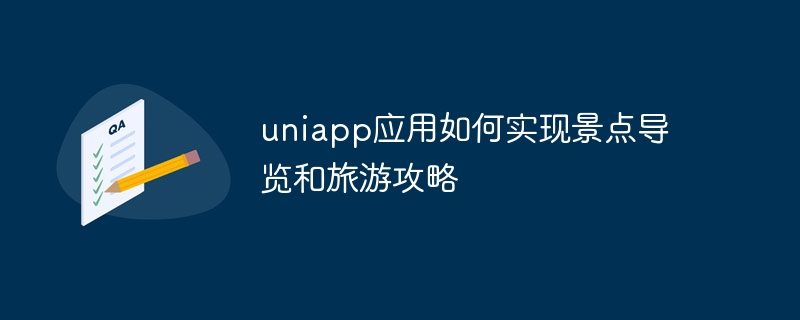

Uniapp is a framework for developing cross-platform applications that can quickly build applications and publish them on multiple platforms. In this article, we will explore how to use Uniapp to implement an application for attraction guides and travel guides.
Before we start, we need to understand the basic concepts and usage of Uniapp. If you are not familiar with this framework yet, it is recommended to study the official documentation first. Now, let's take a look at how to implement attraction navigation and travel guide functions.
First of all, we need a data source to store information about attractions and travel strategies. This can be a local JSON file, or data obtained from a backend server. For the examples in this article, we will use a local JSON file to store the data.
Suppose our data structure is as follows:
{
"sights": [
{
"name": "故宫",
"location": "北京",
"description": "故宫是中国明清两代的皇宫,也称为紫禁城。",
"imageUrl": "https://example.com/gugong.jpg"
},
{
"name": "长城",
"location": "北京",
"description": "长城是中国古代的军事防御工程,被誉为世界七大奇迹之一。",
"imageUrl": "https://example.com/changcheng.jpg"
}
],
"guides": [
{
"name": "北京旅游攻略",
"content": "北京是中国的首都,拥有丰富的历史和文化遗产。"
},
{
"name": "上海旅游攻略",
"content": "上海是中国最大的城市,有许多著名景点和美食。"
}
]
}Next, we need to create two pages, one to display the list of attractions and the other to display the list of travel strategies. We can use Vue syntax to create pages.
First, we create a page called "Sights" to display the list of attractions. In this page, we need to obtain the attraction information from the data source and then display it on the page.
<template>
<view>
<text v-for="sight in sights" :key="sight.name">{{ sight.name }}</text>
</view>
</template>
<script>
export default {
data() {
return {
sights: []
};
},
mounted() {
// 从数据源获取景点信息
// 此处使用uni.request模拟从后端服务器获取数据
uni.request({
url: 'https://example.com/data.json',
success: (res) => {
this.sights = res.data.sights;
}
});
}
};
</script>Then, we create a page called "Guides" to display the list of travel guides. Similar to the previous page, we need to obtain strategy information from the data source and display it on the page.
<template>
<view>
<text v-for="guide in guides" :key="guide.name">{{ guide.name }}</text>
</view>
</template>
<script>
export default {
data() {
return {
guides: []
};
},
mounted() {
// 从数据源获取攻略信息
// 此处使用uni.request模拟从后端服务器获取数据
uni.request({
url: 'https://example.com/data.json',
success: (res) => {
this.guides = res.data.guides;
}
});
}
};
</script>Now, we have created a page that displays a list of attractions and travel guides. Next, we also need to create a navigation bar for switching between two pages.
In the App.vue file, we can use the navigation bar component uni-tabbar to create the navigation bar.
<template>
<view>
<uni-tabbar>
<uni-tab-bar-item text="景点导览" icon="datouxiang" url="/pages/sights"></uni-tab-bar-item>
<uni-tab-bar-item text="旅游攻略" icon="shipin" url="/pages/guides"></uni-tab-bar-item>
</uni-tabbar>
</view>
</template>So far, we have completed the application for displaying attraction guides and travel strategies. You can switch between pages and view specific attraction and guide information.
Please note that in this example, we use a local JSON file as the data source and obtain data from the back-end server through uni.request simulation. In actual development, you may need to use a real backend server to handle data requests.
I hope this article will be helpful to applications that use Uniapp to implement attraction navigation and travel strategies. If you have any questions, please feel free to contact us.
The above is the detailed content of How the uniapp application implements attraction navigation and travel strategies. For more information, please follow other related articles on the PHP Chinese website!
 Implementation method of js barrage function
Implementation method of js barrage function
 What are the java text editors
What are the java text editors
 The difference between currentregion and usedrange
The difference between currentregion and usedrange
 How to cancel automatic renewal of Taobao Money Saving Card
How to cancel automatic renewal of Taobao Money Saving Card
 How to match numbers in regular expressions
How to match numbers in regular expressions
 The meaning of where in sql
The meaning of where in sql
 Is OnePlus or Honor better?
Is OnePlus or Honor better?
 The difference between paste mask and solder mask
The difference between paste mask and solder mask




